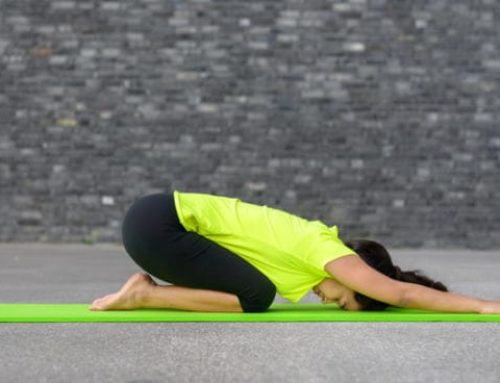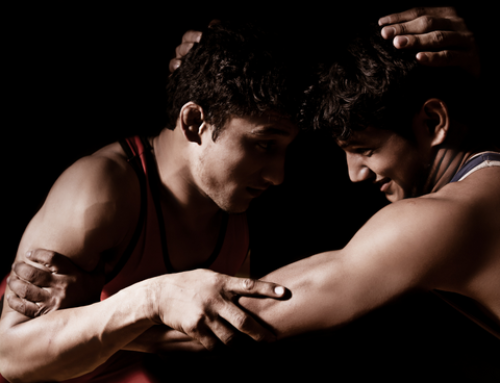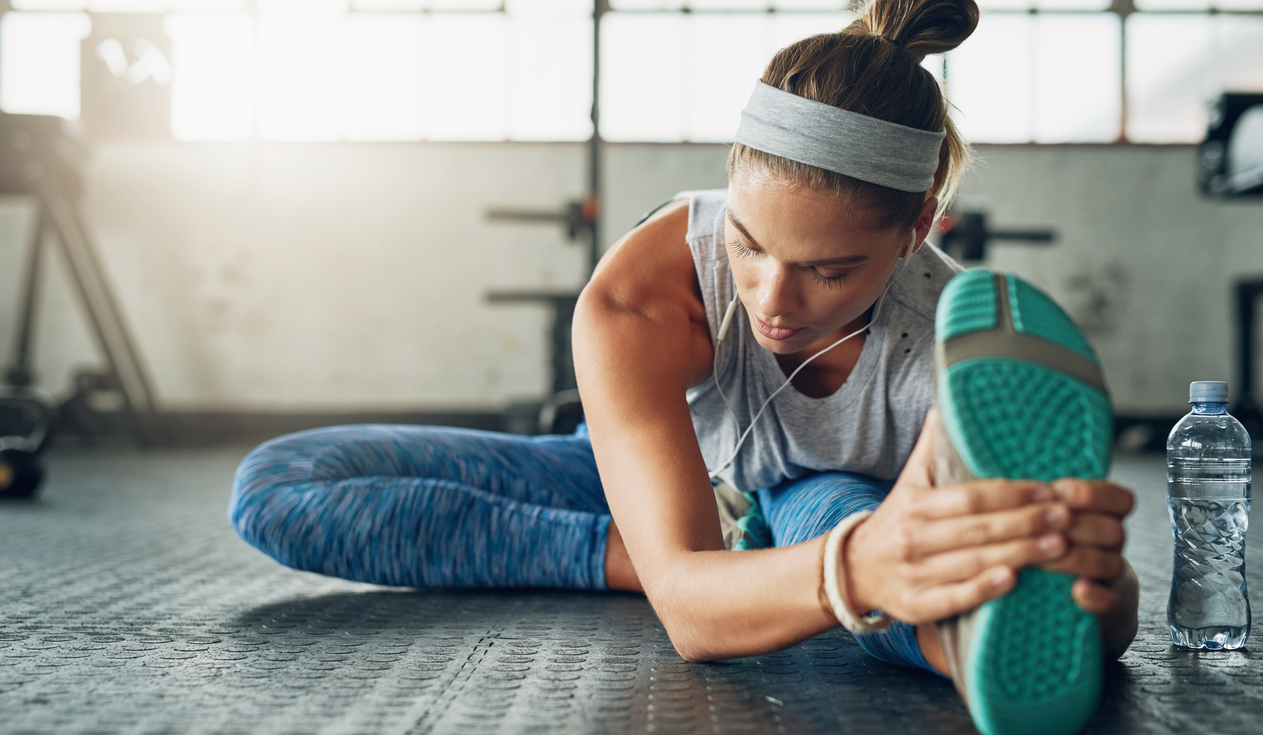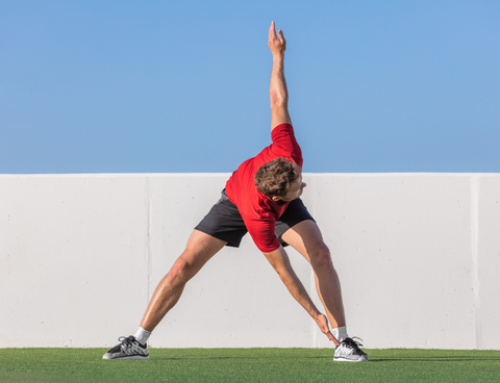Stretching Routine with Ohio State Wrestling
 Ohio State strength coach Anthony Glass explains why great flexibility is an essential skill for all wrestlers and how to improve it.
Ohio State strength coach Anthony Glass explains why great flexibility is an essential skill for all wrestlers and how to improve it.
Great flexibility is as much an advantage to a wrestler as agility, strength and the ability to read the opponent. Flexibility not only lends itself to performing attack maneuvers from difficult positions and preventing adversaries from racking up points, but it lowers risk of injury when one wrestler is stretching another to all corners of the mat. Improved flexibility is what helped The Ohio State Buckeyes 2003-2004 wrestling team placed third in the nation and post a school record of five All-Americans. Needless to say, flexibility training facilitates serious improvements on the mat.
Anthony Glass, director of strength and conditioning for Olympic sports at The Ohio State University in Columbus, Ohio, oversees all aspects of the wrestling team’s training program. But, his emphasis on flexibility has significantly impacted the team’s performance and success. The improvement has been so widespread, Glass can’t single out an individual wrestler whose improved flexibility stands out from the others. “Every last one of them is a success story,” he says.
Glass implements three kinds of stretches to improve the team’s elasticity: active (dynamic) stretches, static stretches and proprioceptive neuromuscular facilitation (PNF) stretches. Each type works muscle groups in different ways to get a more thorough, extensive range of motion that would be achieved with just one type.
To measure each wrestler’s progress and evaluate the effectiveness of the flexibility training, Glass employs a regular range of motion tests including a sit-and-reach test and stand-and-reach test on a box. The test results consistently reveal range increases for every OSU wrestler.
Sit-and-reach Test
To use the sit-and-reach test, sit with your legs in front and fold forward as far as possible. Measure the distance your fingertips reach past your toes.
Stand-and-reach Test
To measure flexibility with the stand-and-reach test, stand on a sturdy box or step and bend forward as far as possible. Measure the distance your fingertips reach past your toes. Use these tests regularly to chart progress.
Active (Dynamic) Warm-Up
Active warm-ups comprise ballistic stretches in which the athlete actively works a muscle through its range of motion. Glass explains that performing these stretches before every daily workout prepares muscles as well as helps increase flexibility. For an active warm-up, Glass uses 20 or more drills that entail his athletes performing a series of movements over a 20-yard distance and repeating the drill back over the same distance. These exercises increase muscle range of motion and develop strength throughout the entire range. The main focus of these drills is increasing a wrestler’s hip flexibility.
Static Stretching
A static stretch is a traditional method of holding a stretch for a specified period of time. According to Glass, this type of flexibility training should not be performed pre-workout. “The static in itself is going to retard the movement of the muscle…and slow you down,” he says..
The Buckeye wrestlers perform static stretches between lifting sets. Glass recommends doing two to four repetitions of each stretch, holding the stretch for no more than six to 15 seconds. For instance, before your next set of squats, perform a quadriceps stretch on each leg.
Proprioceptive Neuromuscular Facilitation Stretching
Glass believes real flexibility improvements result from post-workout flexibility training. He uses a process called proprioceptive neuromuscular facilitation partner stretching, which the Buckeyes perform after every workout during the week. Glass explains, “There are three forms of PNF stretching. These methods are slow-reversal-hold, contract-relax and hold-relax.”
The contract-relax method employs an isometric contraction. For this process, one partner pushes on the one being stretched. The person being stretched contracts the targeted muscle for a few seconds then relax it. While relaxing the muscle, the partner pushing moves the muscle deeper into the stretch. “This is when you really work on your range of motion,” says Glass..
He reminds his athletes that in a sport like wrestling, the opponent does not let up in a position when you begin to feel pain. With this in mind, Glass advises to “go past the point of pain when performing these stretches,” but by no means push to the point of injury. “In wrestling, you are going to have to go a little bit beyond that point [of pain],” Glass says.
He recommends doing two to four stretches on each muscle group holding each stretch for no more than six to 15 seconds.
Final Notes
The key to optimizing the result of each stretch is to work the entire body, according to Glass. “You’ve got to do the total body, that is one thing people neglect. Not only do you need static stretching, but you also need ballistic stretching.”
The importance of flexibility for a wrestler boils down to one idea: “If someone gets you in the wrong position, I don’t care what you try to do. If you don’t have the right range of motion, you are done!”
For more information on flexibility and general training, consult Glass’ book, Weight Training: A Step-by-Step Guide to a Safe and Sound Program.
SAMPLE DYNAMIC WARM-UP
All the recommended exercises move over a 20-yard distance.
Jog Easy jog for 20 yards.
Walking Lunge
Step into a lunge until the front knee comes to a 90-degree angle and the back knee is one inch from the ground and slightly bent; step forward moving the back leg into the front leg position. Repeat for 20 yards. *Do not allow the front knee to move past your toes.
Reverse Walking Lunge
Same principle as walking lunge, but instead step backward into the lunge position.
High Knees
Rapidly drive knees up and down with the opposite arm/opposite leg action (as though you are running). Focus on how quickly you drive your knees up and down rather than how quickly you cover the 20 yards. The more pumps the better.
Shuffle With Arm Swings
Keeping hips low, shuffle while swinging your arms up and down in a jumping jack motion. Your feet should not a crossover.
Swings
Swinging your arms up and down in a jumping jack motion. Your feet should not crossover.
A-Skip
Skip with opposite arm/ opposite leg motion focusing on driving your foot down into the ground.
Sumo squat into jog
Stand with your feet positioned slightly wider than your shoulders and your toes pointed out. With your palms together in front of your chest, slowly squat faring your knees out as you go. Lean forward and press your elbows against the inside of your thighs. Keep heels flat on the ground. Hold for 10 seconds and then jog out for 20 yards.
Forward Somersault Into Jog
Perform a forward roll and then jog out the rest of the 20 yards.
Side Roll Into Jog
Perform a sideways roll and jog out the rest of the 20 yards.
High Knee Tuck
Raise your knee and use both hands to grip your shin. Pull the knee into the chest and upwards as you raise up on your standing foot. Switch legs.
Over Hurdles Forwards/ Reverse
Raise one leg as though you are stepping over an imaginary hurdle. Repeat with other leg.
Straight Leg March
With arms straight out in front of the shoulders, kick one leg up to meet the hands. Step and repeat with other leg.
Lateral Lunge into Carioca
Perform five lateral lunges then carioca the remainder of the yards.
Tuck Jumps Into Jog
Jump as high as possible bringing your knees into a tuck position at the top of the jump. Perform the next jump as soon as you land. Complete five jumps then jog the rest of the 20 yards.
Single Leg Partner Squats
Using a partner’s shoulder to balance, squat down parallel on one leg five times and then repeat with the other leg.
SAMPLE PNF STRETCHES
Partner Hamstring
Lie on your back with a partner pushing one leg back towards your head, while keeping the other flat on the ground. Both legs should be straight the entire time.
Partner Shoulder Girdle
Begin with upper arms parallel to the floor and elbows at a 90-degree angle pointing upward. A partner stands behind and places his arms under your upper arms and pulls back (think full Nelson).
Partner Rear Shoulder Stretch
Put your hands behind your lower back and have a partner raise your arms as high as possible keeping the elbows locked.
Quadriceps
Pull a foot towards the glutes keeping the upper leg perpendicular to the ground. Use your own hand to offer resistance.
Partner Hip Flexor
Get into lunge position until the front leg is at a 90-degree angle and the back knee is an inch off the ground. Slightly arch back and lean back with the upper body. Do not allow the front knee to go over the front foot. The partner should gently pull back on your chest.
Sumo Squat Stretch
Stand with your feet positioned slightly wider than shoulders and toes pointed out. With your palms in front of your chest, slowly squat down flaring your knees out as you go. Lean forward and press your elbows against the inside of your thighs. Keep heels flat on the ground.
Partner Sit-and-Reach
Sit with legs extended straight in front of you. Have your partner push on your upper back causing you to fold over your legs.
Partner Sit-and-Reach (Arched Back)
Sit with legs extended straight in front of you. Have your partner push on your upper back causing you to fold over your legs, but keep lower back arched.
Calf Stretch
Stand a couple of feet from a wall and lean until your chest touches the wall. Keep heels on the ground.
RECOMMENDED FOR YOU
MOST POPULAR
Stretching Routine with Ohio State Wrestling
 Ohio State strength coach Anthony Glass explains why great flexibility is an essential skill for all wrestlers and how to improve it.
Ohio State strength coach Anthony Glass explains why great flexibility is an essential skill for all wrestlers and how to improve it.
Great flexibility is as much an advantage to a wrestler as agility, strength and the ability to read the opponent. Flexibility not only lends itself to performing attack maneuvers from difficult positions and preventing adversaries from racking up points, but it lowers risk of injury when one wrestler is stretching another to all corners of the mat. Improved flexibility is what helped The Ohio State Buckeyes 2003-2004 wrestling team placed third in the nation and post a school record of five All-Americans. Needless to say, flexibility training facilitates serious improvements on the mat.
Anthony Glass, director of strength and conditioning for Olympic sports at The Ohio State University in Columbus, Ohio, oversees all aspects of the wrestling team’s training program. But, his emphasis on flexibility has significantly impacted the team’s performance and success. The improvement has been so widespread, Glass can’t single out an individual wrestler whose improved flexibility stands out from the others. “Every last one of them is a success story,” he says.
Glass implements three kinds of stretches to improve the team’s elasticity: active (dynamic) stretches, static stretches and proprioceptive neuromuscular facilitation (PNF) stretches. Each type works muscle groups in different ways to get a more thorough, extensive range of motion that would be achieved with just one type.
To measure each wrestler’s progress and evaluate the effectiveness of the flexibility training, Glass employs a regular range of motion tests including a sit-and-reach test and stand-and-reach test on a box. The test results consistently reveal range increases for every OSU wrestler.
Sit-and-reach Test
To use the sit-and-reach test, sit with your legs in front and fold forward as far as possible. Measure the distance your fingertips reach past your toes.
Stand-and-reach Test
To measure flexibility with the stand-and-reach test, stand on a sturdy box or step and bend forward as far as possible. Measure the distance your fingertips reach past your toes. Use these tests regularly to chart progress.
Active (Dynamic) Warm-Up
Active warm-ups comprise ballistic stretches in which the athlete actively works a muscle through its range of motion. Glass explains that performing these stretches before every daily workout prepares muscles as well as helps increase flexibility. For an active warm-up, Glass uses 20 or more drills that entail his athletes performing a series of movements over a 20-yard distance and repeating the drill back over the same distance. These exercises increase muscle range of motion and develop strength throughout the entire range. The main focus of these drills is increasing a wrestler’s hip flexibility.
Static Stretching
A static stretch is a traditional method of holding a stretch for a specified period of time. According to Glass, this type of flexibility training should not be performed pre-workout. “The static in itself is going to retard the movement of the muscle…and slow you down,” he says..
The Buckeye wrestlers perform static stretches between lifting sets. Glass recommends doing two to four repetitions of each stretch, holding the stretch for no more than six to 15 seconds. For instance, before your next set of squats, perform a quadriceps stretch on each leg.
Proprioceptive Neuromuscular Facilitation Stretching
Glass believes real flexibility improvements result from post-workout flexibility training. He uses a process called proprioceptive neuromuscular facilitation partner stretching, which the Buckeyes perform after every workout during the week. Glass explains, “There are three forms of PNF stretching. These methods are slow-reversal-hold, contract-relax and hold-relax.”
The contract-relax method employs an isometric contraction. For this process, one partner pushes on the one being stretched. The person being stretched contracts the targeted muscle for a few seconds then relax it. While relaxing the muscle, the partner pushing moves the muscle deeper into the stretch. “This is when you really work on your range of motion,” says Glass..
He reminds his athletes that in a sport like wrestling, the opponent does not let up in a position when you begin to feel pain. With this in mind, Glass advises to “go past the point of pain when performing these stretches,” but by no means push to the point of injury. “In wrestling, you are going to have to go a little bit beyond that point [of pain],” Glass says.
He recommends doing two to four stretches on each muscle group holding each stretch for no more than six to 15 seconds.
Final Notes
The key to optimizing the result of each stretch is to work the entire body, according to Glass. “You’ve got to do the total body, that is one thing people neglect. Not only do you need static stretching, but you also need ballistic stretching.”
The importance of flexibility for a wrestler boils down to one idea: “If someone gets you in the wrong position, I don’t care what you try to do. If you don’t have the right range of motion, you are done!”
For more information on flexibility and general training, consult Glass’ book, Weight Training: A Step-by-Step Guide to a Safe and Sound Program.
SAMPLE DYNAMIC WARM-UP
All the recommended exercises move over a 20-yard distance.
Jog Easy jog for 20 yards.
Walking Lunge
Step into a lunge until the front knee comes to a 90-degree angle and the back knee is one inch from the ground and slightly bent; step forward moving the back leg into the front leg position. Repeat for 20 yards. *Do not allow the front knee to move past your toes.
Reverse Walking Lunge
Same principle as walking lunge, but instead step backward into the lunge position.
High Knees
Rapidly drive knees up and down with the opposite arm/opposite leg action (as though you are running). Focus on how quickly you drive your knees up and down rather than how quickly you cover the 20 yards. The more pumps the better.
Shuffle With Arm Swings
Keeping hips low, shuffle while swinging your arms up and down in a jumping jack motion. Your feet should not a crossover.
Swings
Swinging your arms up and down in a jumping jack motion. Your feet should not crossover.
A-Skip
Skip with opposite arm/ opposite leg motion focusing on driving your foot down into the ground.
Sumo squat into jog
Stand with your feet positioned slightly wider than your shoulders and your toes pointed out. With your palms together in front of your chest, slowly squat faring your knees out as you go. Lean forward and press your elbows against the inside of your thighs. Keep heels flat on the ground. Hold for 10 seconds and then jog out for 20 yards.
Forward Somersault Into Jog
Perform a forward roll and then jog out the rest of the 20 yards.
Side Roll Into Jog
Perform a sideways roll and jog out the rest of the 20 yards.
High Knee Tuck
Raise your knee and use both hands to grip your shin. Pull the knee into the chest and upwards as you raise up on your standing foot. Switch legs.
Over Hurdles Forwards/ Reverse
Raise one leg as though you are stepping over an imaginary hurdle. Repeat with other leg.
Straight Leg March
With arms straight out in front of the shoulders, kick one leg up to meet the hands. Step and repeat with other leg.
Lateral Lunge into Carioca
Perform five lateral lunges then carioca the remainder of the yards.
Tuck Jumps Into Jog
Jump as high as possible bringing your knees into a tuck position at the top of the jump. Perform the next jump as soon as you land. Complete five jumps then jog the rest of the 20 yards.
Single Leg Partner Squats
Using a partner’s shoulder to balance, squat down parallel on one leg five times and then repeat with the other leg.
SAMPLE PNF STRETCHES
Partner Hamstring
Lie on your back with a partner pushing one leg back towards your head, while keeping the other flat on the ground. Both legs should be straight the entire time.
Partner Shoulder Girdle
Begin with upper arms parallel to the floor and elbows at a 90-degree angle pointing upward. A partner stands behind and places his arms under your upper arms and pulls back (think full Nelson).
Partner Rear Shoulder Stretch
Put your hands behind your lower back and have a partner raise your arms as high as possible keeping the elbows locked.
Quadriceps
Pull a foot towards the glutes keeping the upper leg perpendicular to the ground. Use your own hand to offer resistance.
Partner Hip Flexor
Get into lunge position until the front leg is at a 90-degree angle and the back knee is an inch off the ground. Slightly arch back and lean back with the upper body. Do not allow the front knee to go over the front foot. The partner should gently pull back on your chest.
Sumo Squat Stretch
Stand with your feet positioned slightly wider than shoulders and toes pointed out. With your palms in front of your chest, slowly squat down flaring your knees out as you go. Lean forward and press your elbows against the inside of your thighs. Keep heels flat on the ground.
Partner Sit-and-Reach
Sit with legs extended straight in front of you. Have your partner push on your upper back causing you to fold over your legs.
Partner Sit-and-Reach (Arched Back)
Sit with legs extended straight in front of you. Have your partner push on your upper back causing you to fold over your legs, but keep lower back arched.
Calf Stretch
Stand a couple of feet from a wall and lean until your chest touches the wall. Keep heels on the ground.










